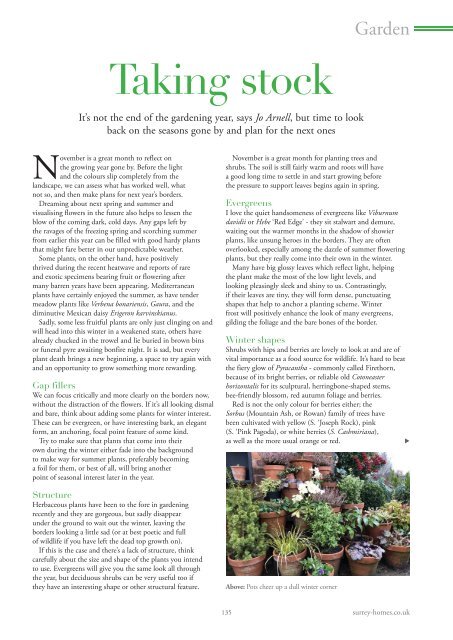Surrey Homes | SH49 | November 2018 | Gift supplement inside
The lifestyle magazine for Surrey - Inspirational Interiors, Fabulous Fashion, Delicious Dishes
The lifestyle magazine for Surrey - Inspirational Interiors, Fabulous Fashion, Delicious Dishes
Create successful ePaper yourself
Turn your PDF publications into a flip-book with our unique Google optimized e-Paper software.
Garden<br />
Taking stock<br />
It’s not the end of the gardening year, says Jo Arnell, but time to look<br />
back on the seasons gone by and plan for the next ones<br />
<strong>November</strong> is a great month to reflect on<br />
the growing year gone by. Before the light<br />
and the colours slip completely from the<br />
landscape, we can assess what has worked well, what<br />
not so, and then make plans for next year’s borders.<br />
Dreaming about next spring and summer and<br />
visualising flowers in the future also helps to lessen the<br />
blow of the coming dark, cold days. Any gaps left by<br />
the ravages of the freezing spring and scorching summer<br />
from earlier this year can be filled with good hardy plants<br />
that might fare better in our unpredictable weather.<br />
Some plants, on the other hand, have positively<br />
thrived during the recent heatwave and reports of rare<br />
and exotic specimens bearing fruit or flowering after<br />
many barren years have been appearing. Mediterranean<br />
plants have certainly enjoyed the summer, as have tender<br />
meadow plants like Verbena bonariensis, Gaura, and the<br />
diminutive Mexican daisy Erigeron karvinskianus.<br />
Sadly, some less fruitful plants are only just clinging on and<br />
will head into this winter in a weakened state, others have<br />
already chucked in the trowel and lie buried in brown bins<br />
or funeral pyre awaiting bonfire night. It is sad, but every<br />
plant death brings a new beginning, a space to try again with<br />
and an opportunity to grow something more rewarding.<br />
Gap fillers<br />
We can focus critically and more clearly on the borders now,<br />
without the distraction of the flowers. If it’s all looking dismal<br />
and bare, think about adding some plants for winter interest.<br />
These can be evergreen, or have interesting bark, an elegant<br />
form, an anchoring, focal point feature of some kind.<br />
Try to make sure that plants that come into their<br />
own during the winter either fade into the background<br />
to make way for summer plants, preferably becoming<br />
a foil for them, or best of all, will bring another<br />
point of seasonal interest later in the year.<br />
Structure<br />
Herbaceous plants have been to the fore in gardening<br />
recently and they are gorgeous, but sadly disappear<br />
under the ground to wait out the winter, leaving the<br />
borders looking a little sad (or at best poetic and full<br />
of wildlife if you have left the dead top growth on).<br />
If this is the case and there’s a lack of structure, think<br />
carefully about the size and shape of the plants you intend<br />
to use. Evergreens will give you the same look all through<br />
the year, but deciduous shrubs can be very useful too if<br />
they have an interesting shape or other structural feature.<br />
<strong>November</strong> is a great month for planting trees and<br />
shrubs. The soil is still fairly warm and roots will have<br />
a good long time to settle in and start growing before<br />
the pressure to support leaves begins again in spring.<br />
Evergreens<br />
I love the quiet handsomeness of evergreens like Viburnum<br />
davidii or Hebe ‘Red Edge’ - they sit stalwart and demure,<br />
waiting out the warmer months in the shadow of showier<br />
plants, like unsung heroes in the borders. They are often<br />
overlooked, especially among the dazzle of summer flowering<br />
plants, but they really come into their own in the winter.<br />
Many have big glossy leaves which reflect light, helping<br />
the plant make the most of the low light levels, and<br />
looking pleasingly sleek and shiny to us. Contrastingly,<br />
if their leaves are tiny, they will form dense, punctuating<br />
shapes that help to anchor a planting scheme. Winter<br />
frost will positively enhance the look of many evergreens,<br />
gilding the foliage and the bare bones of the border.<br />
Winter shapes<br />
Shrubs with hips and berries are lovely to look at and are of<br />
vital importance as a food source for wildlife. It’s hard to beat<br />
the fiery glow of Pyracantha - commonly called Firethorn,<br />
because of its bright berries, or reliable old Cotoneaster<br />
horizontalis for its sculptural, herringbone-shaped stems,<br />
bee-friendly blossom, red autumn foliage and berries.<br />
Red is not the only colour for berries either; the<br />
Sorbus (Mountain Ash, or Rowan) family of trees have<br />
been cultivated with yellow (S. ‘Joseph Rock), pink<br />
(S. ‘Pink Pagoda), or white berries (S. Cashmiriana),<br />
as well as the more usual orange or red.<br />
Above: Pots cheer up a dull winter corner<br />
<br />
135 surrey-homes.co.uk


















